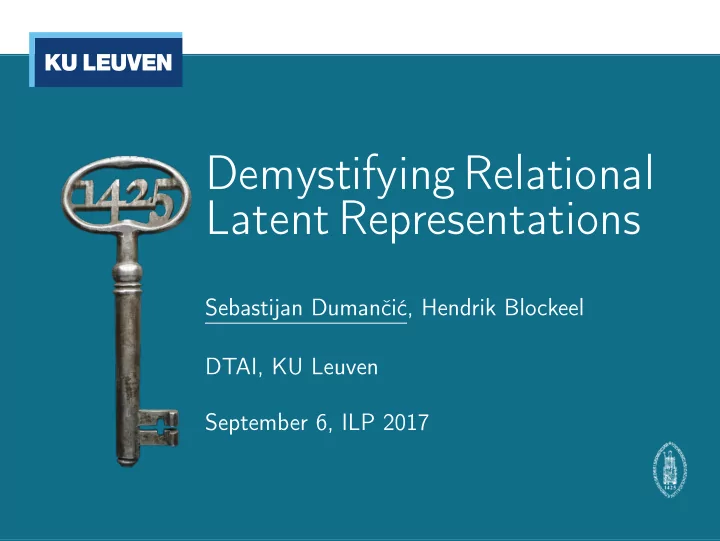

Demystifying Relational Latent Representations Sebastijan Dumančić, Hendrik Blockeel DTAI, KU Leuven September 6, ILP 2017
1 – Outline 2/24 1 Introduction 2 Understanding latent features 3 Properties of latent spaces Demystifying Relational Latent Representations – Dumančić, Blockeel
1 – Learning Relational Latent Representations 3/24 Learning versatile relational latent features with clustering and variety of similarities (CUR 2 LED) [Dumančić and Blockeel, IJCAI 2017] Demystifying Relational Latent Representations – Dumančić, Blockeel
1 – Learning Relational Latent Representations 4/24 Benefits: better performance simpler models [with some overhead] Questions to be answered Can we interpret latent features? 1 (approximate) definition of latent features/relations What makes them effective? 2 distinctive properties? Demystifying Relational Latent Representations – Dumančić, Blockeel
2 – Outline 5/24 1 Introduction 2 Understanding latent features 3 Properties of latent spaces Demystifying Relational Latent Representations – Dumančić, Blockeel
2 – Understanding latent features 6/24 latent features = clusters of vertices (instances) and edges (relationships) key idea: cluster prototype represents the meaning of a feature Demystifying Relational Latent Representations – Dumančić, Blockeel
2 – Understanding features - technicalities (1) 7/24 CUR 2 LED uses ReCeNT as a similarity measure for relational data ⇒ views instances as neighbourhood trees Data Neighbourhood tree [Dumančić and Blockeel, MLJ 2017] Demystifying Relational Latent Representations – Dumančić, Blockeel
2 – Understanding features - technicalities (1) 8/24 CUR 2 LED uses ReCeNT as a similarity measure for relational data ⇒ views instances as neighbourhood trees Data Neighbourhood tree key idea: mean tree represents the meaning of a feature Demystifying Relational Latent Representations – Dumančić, Blockeel
2 – Understanding features - technicalities (2) 9/24 CUR 2 LED requires a (set of) similarity interpretation(s) → a specification what similarity reflects attribute sim neighbourhood attributes sim neighbourhood identity edge labels connectedness key idea: find a mean tree given the similarity interpretation Demystifying Relational Latent Representations – Dumančić, Blockeel
2 – Understanding features - technicalities (3) 10/24 CUR 2 LED compares neighbourhood trees by comparing distributions of elements within them elements selected by the similarity interpretation attributes values, edge types, identities ... key idea: mean tree ≈ elements that appear in all NTs (in a cluster) with similar frequency Demystifying Relational Latent Representations – Dumančić, Blockeel
2 – Understanding features - outline 11/24 Given a set of neighbourhood tree and a similarity interpretation ... 1. Demystifying Relational Latent Representations – Dumančić, Blockeel
2 – Understanding features - outline 12/24 Calculate the relative frequencies of elements within a tree 1. 2. Demystifying Relational Latent Representations – Dumančić, Blockeel
2 – Understanding features - outline 13/24 Summarize the relative frequencies of unique elements across trees 1. 2. 3. Demystifying Relational Latent Representations – Dumančić, Blockeel
2 – Understanding features - outline 14/24 Select elements with low standard deviation 1. 2. 3. ( θ -confidence) An element with mean value µ and standard deviation σ in a cluster, is said to be θ -confident if σ < θ · µ . Demystifying Relational Latent Representations – Dumančić, Blockeel
2 – Understanding features - results 15/24 Use case: IMDB Demystifying Relational Latent Representations – Dumančić, Blockeel
2 – Understanding features - results 16/24 Use case: UWCSE Demystifying Relational Latent Representations – Dumančić, Blockeel
3 – Outline 17/24 1 Introduction 2 Understanding latent features 3 Properties of latent spaces Demystifying Relational Latent Representations – Dumančić, Blockeel
3 – Why are they effective? 18/24 Properties of latent spaces: label entropy distribution of labels within true instantiations of predicates proxy to a quantification of learning difficulty sparsity modelling local vs. global concept spread across a small number of local regions is easier to capture redundancy CUR 2 LED creates many features - are all of them necessary? Demystifying Relational Latent Representations – Dumančić, Blockeel
3 – Why are they effective? - label entropy 19/24 no improvement (1) improved performance (3) when performance increases, latent representation has many predicates of low label entropy Demystifying Relational Latent Representations – Dumančić, Blockeel
3 – Why are they effective? - sparsity 20/24 improved performance (3) no improvement (1) when performance increases, latent representation is sparser than the original one Demystifying Relational Latent Representations – Dumančić, Blockeel
3 – Why are they effective? - entropy vs. sparsity 21/24 Trivial explanation: many predicates with a very small number of true instantiations (not helpful) no improvement (1) improved performance (3) ... not what’s happening here: latent predicates have a comparable number of true instantiations Demystifying Relational Latent Representations – Dumančić, Blockeel
3 – Why are they effective? 22/24 latent features successfully identify local regions in the instance space that match well with the provided labels Demystifying Relational Latent Representations – Dumančić, Blockeel
3 – Why are they effective? - redundancy 23/24 CUR 2 LED creates a lot of features similarity interpretations considered independently but many instances might be identical in several similarity interpretations every time a new clustering is obtained, check how much it overlaps with an existing clusterings using the adjusted Rand index Demystifying Relational Latent Representations – Dumančić, Blockeel
Thank you! Questions? Demystifying Relational Latent Representations – Dumančić, Blockeel
Recommend
More recommend